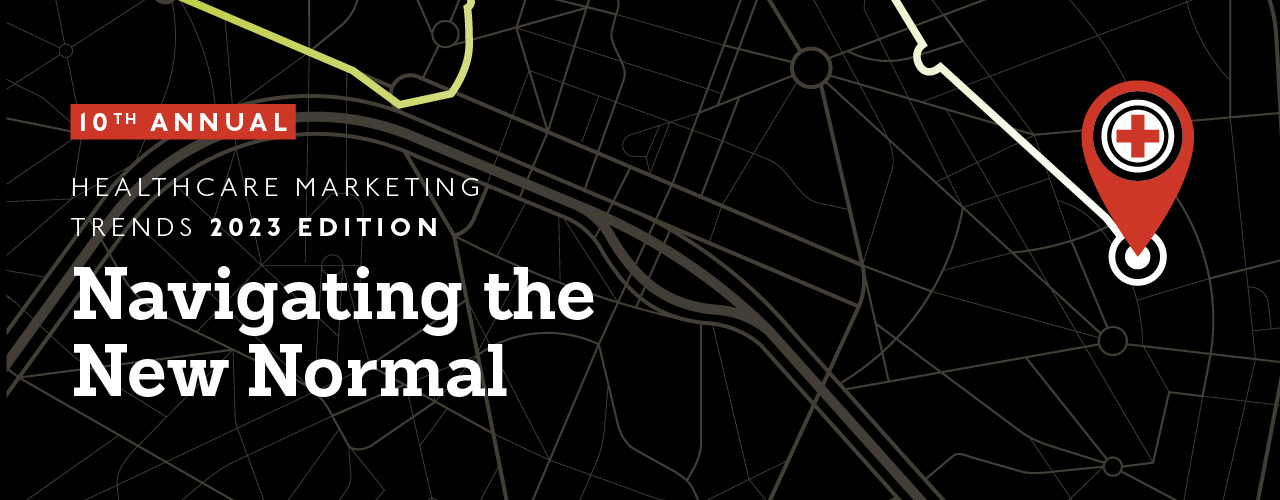A Quick Guide to our 2023 Healthcare Marketing Trends
In case you missed it, last month we released our 10th Annual Healthcare Marketing Trends report from the floor of SHSMD! We had a blast handing out physical copies at our booth. If you haven’t had a chance to read the report yet, watch our overview webinar below, or keep reading for a quick summary of each trend.
Trend #1 – The High Cost of Low Morale
Soon, it will have been three years since things turned upside down, and healthcare workers were expected to jump in and correct them. As COVID-19 continues its unrelenting reign, our staff has been forced to weather constantly-changing protocols, the closing and reopening of services, and increased workloads.
The result has been increased stress, mental health issues, and your staff leaving for new opportunities or changing careers entirely. We need to turn the ship around. It starts not with finding new staff but with taking care of our current team.
- Reassign tasks and workloads.
- Build opportunities for regular connection.
- Focus on overall employee well-being.
- Reward and recognize.
Trend #2 – Zeroing in on Recruitment
We saw the healthcare recruitment issue accelerate faster in the last two years than any of us predicted. It’s grown from an inconvenience to dramatically affect patient safety, staff morale, and the bottom line greater than ever before. How can you move forward? You need smarter targeting.
It’s all about reaching the right people, in the right place, at the right time, with the right message to get someone to switch from their current employer to you. So, let’s help focus your campaigns and develop a better targeting strategy. You already know the people, or their job titles and qualifications, so let’s focus on the right place and time. In the report, we dive into commuter advertising and geofencing.
Trend #3 – Using Data to Fuel Growth
In this section, we talk about what we can learn from growth marketing. Growth marketing is about using your data to drive your marketing decisions forward and constantly experimenting and iterating on your messaging, creative, and other tactics to continuously improve your results. We talked about three ways to get started:
- Think beyond A/B testing.
- Keep your funnel engaged with personalized content.
- Start a texting strategy.
Trend #4 – The Competition is Heating Up
Simply said, patients are customers. And customers enjoy “everyday low prices,” two-day shipping, and the many other conveniences of big box stores. So it’s no surprise (well, maybe it is) that Dollar Tree, Walmart, and Amazon have joined CVS and Walgreens by stepping deeper into the healthcare space. They want to meet the patient’s needs in places where hospitals and health systems lack the resources to do the same. So, what are the strategies that hospitals and health systems can embrace to compete in this new marketplace? We suggest three areas:
- Patient Experience.
- Authenticity.
- Technology.
Trend #5 – Winning Social Proof
Social proof is an important element of digital marketing, especially in healthcare marketing where trust really matters. So how can healthcare marketers win at social proof? We give ideas for building brand trust and loyalty around the following strategies:
- Reviews and testimonials.
- Earned Media.
- Influencers and Brand Partnerships.
- Data.
- Awards and Recognitions.
- User-Generated Content.
Trend #6 – Virtual is just a piece of the puzzle
Finally, we iterate that virtual care is just a part of your continuum of care. It can’t and shouldn’t replace everything. Nothing can replace the empathy and connection that comes from being in person with a patient. Whether they’re nervous about a test result, excitedly waiting to meet their baby through an ultrasound, or just confused and needing someone to talk to. People in these vulnerable states shouldn’t always be pushed to use telehealth. Especially after the digital exhaustion many of us face as we continue to work and study remotely. Many of us are still in desperate need of human connection.

